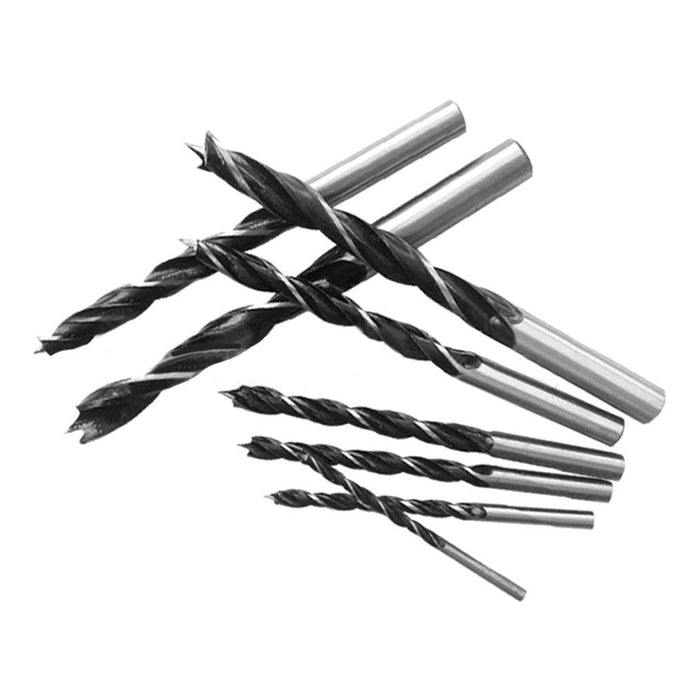|
Brad point drill bits are widely regarded as one of the best tools for precision drilling in woodworking. Their sharp center point and two cutting edges help to create clean, accurate holes with minimal splintering, making them the go-to choice for woodworkers. But what about using a brad point drill bit for metal? While it might seem intuitive to use the same bit for different materials, it's essential to understand the unique characteristics of brad point drill bits and how they interact with harder substances like metal. In this article, we'll explore the performance of brad point drill bits on metal, the limitations you may encounter, and whether they are suitable for certain types of metal drilling tasks.
Brad point drill bits - Findbuytool are designed primarily for wood, plywood, and similar materials. The distinctive feature of a brad point bit is its sharp, pointed tip, which helps the bit stay in place and prevents wandering when it makes contact with the surface. This is particularly important in woodworking, where a precise entry point is essential for achieving clean, accurate holes. The two main cutting edges of the brad point bit are also highly effective at removing material quickly while ensuring the hole's sides remain smooth and free of splinters.
However, when it comes to metal, the situation changes. Metal is far harder than wood and requires more specialized tools to achieve a clean and precise hole. Traditional brad point drill bits, with their fine tips and cutting edges, are not typically designed to handle the high heat and stress generated when drilling through metal. Metals like steel, aluminum, and brass demand a higher level of durability and cutting power than wood, and a brad point bit often cannot meet these needs effectively.
When drilling through metal, brad point bits can struggle for several reasons. First, the sharp point that makes brad point bits so effective in wood can become a disadvantage in metal. Because metal is much denser, the point of a brad point bit may not penetrate as easily, leading to unnecessary wear on the bit. The heat generated from this friction can also dull the bit quickly, reducing its effectiveness and lifespan. The bit may also tend to wander or slip, particularly on smooth or hard metal surfaces, since it lacks the necessary durability to withstand the challenges of metal drilling.
Additionally, the cutting edges of a brad point drill bit are optimized for removing wood chips, not the tougher shavings produced when drilling metal. The bit's design is focused on creating clean holes in relatively soft materials, not on the high-speed, high-torque demands of metal drilling. As a result, a brad point drill bit may not provide the necessary cutting power, and you could end up with a rough hole, poor finish, and possible damage to both the metal and the bit itself.
So, can you use a brad point drill bit for metal? The short answer is yes, but it's not recommended for most situations. If you only need to drill through very thin, soft metals, such as aluminum sheets or brass, you might be able to use a brad point bit with some success. However, even in these cases, you should be cautious and mindful of the bit's limitations. It's important to use proper lubrication to minimize heat buildup and keep the bit cool while drilling. A slower drilling speed and light pressure are also crucial to ensure the bit doesn't wear down prematurely.
For more serious metal drilling tasks, a specialized metal drill bit is a much better choice. Twist drill bits, for example, are designed for drilling through metal, featuring a more robust and durable construction that can handle the hardness of metals. These bits are typically made from high-speed steel (HSS) or cobalt steel, which can withstand the heat and pressure generated during metal drilling. Twist drill bits have a spiral design that helps to efficiently remove metal shavings, preventing the bit from becoming clogged and allowing for smoother, cleaner holes. For even tougher materials like stainless steel, cobalt drill bits are often the best option due to their superior strength and heat resistance.
Another option for drilling into metal is the step drill bit, which is designed to create holes of varying diameters and can work well for thin sheet metal. The step drill bit allows you to drill multiple sizes of holes without having to switch out different bits, making it ideal for tasks that involve drilling several holes in metal sheets.
While brad point drill bits may have their place in light metal drilling, they are far from the ideal choice for most applications. If you regularly work with metal, investing in a set of high-quality metal drill bits will make your tasks easier and more efficient. The right drill bit will not only help you achieve cleaner, more accurate holes but also extend the life of your tools and improve the overall quality of your work.
In conclusion, brad point drill bits are excellent for woodworking but fall short when it comes to drilling metal. Their fine point and cutting design are not suited to the demands of metal drilling, and using them on tougher materials can lead to poor results and premature wear. For metal drilling tasks, it's always best to use a bit designed specifically for the job. That said, if you're only dealing with very soft metals or need to drill a few small holes, a brad point bit might suffice, as long as you use it carefully and with the right techniques. However, for anything more substantial, it's wise to reach for a drill bit built for the job.

|